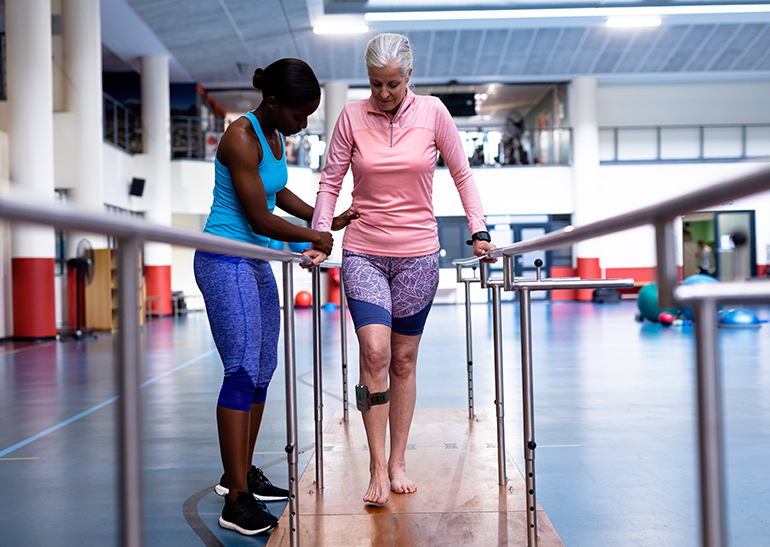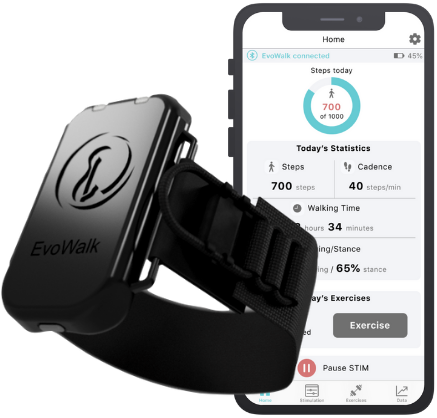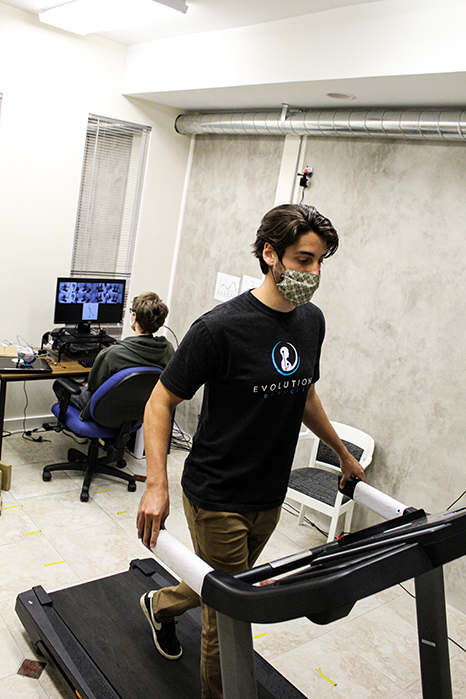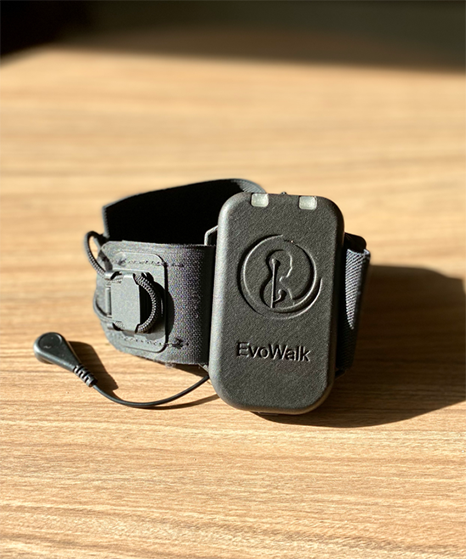
Evolution Devices, a company based in California, created a functional electrical stimulation device to assist people with foot drop to walk more freely. Foot drop is caused by muscle weakness/paralysis, and those affected struggle to lift the front part of their foot, which makes walking difficult and can lead to falls.

The product is called EvoWalk, and it consists of an electrical stimulation device that stimulates muscles in the leg that can lift the foot at exactly the right time during walking. The device gathers data on patient activity which can be monitored by a physical therapist remotely and during in-person sessions. In fact, the system pairs a device user with a physical therapist, who guides them through a rehabilitation program over a video link.
The idea is that by completing prescribed exercises and using the stimulation device, patients can start to regain some of their mobility and increase their confidence in walking while avoiding falls. Medgadget had the opportunity to speak with Pierluigi Mantovani, Co-Founder & CEO at Evolution Devices, about the technology and its supporting digital ecosystem.
Conn Hastings, Medgadget: Please give us an overview of foot drop, and its causes and consequences.

Pierluigi Mantovani, Evolution Devices: Foot drop is a muscular weakness or paralysis that makes it difficult to lift the front part of the foot and toes. It can cause people to drag their foot on the ground when walking, which often leads to trips and falls. Foot drop is not a disease in itself and is usually the result of greater health problems, such as multiple sclerosis, stroke, or spinal cord injury. People with foot drop will typically compensate with movements such as excessive outward leg-swinging and/or shorter strides to try and avoid scuffs, trips, or falling during walking. These movements are typically unsafe, lead to other injuries, and cause excessive fatigue. As a result, people with foot drop lose their motivation to walk and feel a loss of independence, further deteriorating health, and quality of life.
Medgadget: How is the condition currently treated? How much room for improvement is there?
Mantovani: Patients are typically prescribed physical therapy to treat their foot drop and the associated walking problems caused by the movements they make to compensate. Aside from physical therapy, patients are typically prescribed assistive devices to use while at home.
The standard of care for foot drop patients is a rigid ankle-foot orthosis (AFO) that fixes the ankle to a flexed position to prevent the toes from scuffing. These AFOs act as removable braces to hold the foot in place, but are very bulky and do not help in the rehabilitation of walking in any way – they are simply meant to help prevent falls.
Alternatively, patients may use a functional electrical stimulation (FES) device, which stimulates leg muscles during walking to aid in their rehabilitation and prevent falls. FES has known, scientifically published functional and physiological benefits for treating foot drop in stroke, spinal cord injury, traumatic brain injury, and multiple sclerosis patients. One major benefit of FES over an AFO is that FES often restores neurological connections, increasing maximum voluntary muscle contractions.
Current foot drop stimulators are helpful, but still very limiting. They rely on decades-old technology to control the timing of muscle activation, which often leads to improper timing of stimulation – a problem that is unsafe for the patient, requires frequent readjustment, and limits the potential benefits of neuroplasticity. Additionally, the devices are bulky and expensive. Not to mention, these outdated algorithms do not track activity, so neither clinicians nor patients can take control of their daily activity data to improve rehabilitation.
The existing solutions were built with decades-old technology. People with walking impairments need modern solutions to receive better care and restore their independence.
Medgadget: Please give us an overview of the EvoWalk Digital Therapy Platform, and its various components.

Mantovani: The EvoWalk platform is a digital physical therapy solution enabled by an AI-powered muscle stimulation device. The EvoWalk device gathers detailed walking data and provides electrotherapy to stimulate muscles at the right time to rehab walking and prevent falls. Patients and their physical therapists use data generated by EvoWalk to set personalized goals and care plans.
How the EvoWalk Platform Works:
- A patient is matched with a certified neurologic PT who assesses them remotely via a secure HIPAA-compliant video platform
- The patient receives the EvoWalk device and downloads the patient app
- Dedicated PTs train the patient on the EvoWalk and develop a customized therapy program that evolves as their rehab progresses
- While wearing the EvoWalk device, the patient walks more freely as it provides personalized stimulation that lifts the patient’s foot at precisely the right times
- Mobility data is automatically collected and shared with the patient and therapist and is used to update/refine their rehab therapy
Medgadget: How does the stimulation device assist people with foot drop to walk more freely?
Mantovani: The EvoWalk is a smart Functional Electrical Stimulation (FES) device. It externally stimulates the right muscles at the right time to help pick up the foot while walking, prevent scuffs and falls, and helping people be more confident in their walking ability. Additionally, the EvoWalk device gathers detailed walking data specific to rehabilitate walking and prevent falls. Patients and their physical therapists use the data generated by EvoWalk to set personalized goals and care plans. Our goal is to empower people to take ownership of their rehabilitation and eventually regain independence.
Medgadget: What role does artificial intelligence play in how the device operates?

Mantovani: The EvoWalk has a built-in accelerometer and gyroscope which run patent-pending AI algorithms. These A.I. algorithms serve two functions. First, the A.I. helps stimulate the correct muscles at the correct time for each individual person. Everyone walks a bit differently and requires slightly different timing, which the EvoWalk accounts for to provide comfortably timed stimulation. Second, the A.I. collects detailed data about how a person is walking and progressing over time. This data from the EvoWalk A.I. helps power the EvoWalk physical therapy platform. The EvoWalk therapy platform connects patients with Neuro-certified physical therapists who guide patients through personalized care plans enabled by the data collected by the EvoWalk device.
Medgadget: How does the device pair with the app, and how do physical therapists interact with the device users?
Mantovani: The device pairs with the app via bluetooth, just as other well-known wearable devices would. For the first time, physical therapists can now see actionable patient activity and exercise data from a patient’s natural, everyday life, empowering them to deliver higher quality remote care (something proven to be essential because of the pandemic).
Previously PT’s only had the ability to prescribe exercises based on their controlled setting inside a clinic – somewhere that is not like what a person goes through throughout their day (for example hills, stairs, turns in a grocery store, all these things that contribute to how a person walks in real-life).
Now for example, if a therapist notices that the patient is walking less on certain days, or in the mornings, the therapist can use this information to speak with the patient and understand why that is. On another level, since the EvoWalk provides detailed data about how the patient’s body moves, the PT can use data to prescribe more specific exercises based on how the patient moves throughout their day-to-day. For example, a therapist may notice that the patient has difficulty bending their knee throughout the day, so the therapist can adjust their prescribed exercises to focus on strengthening the muscles used to bend the knee.
Being able to see patients’ at-home data leads to more dynamic, personalized treatment that improves patient engagement and outcomes.

Check out this video of a stroke survivor competing in a 5K race with the help of the EvoWalk:
